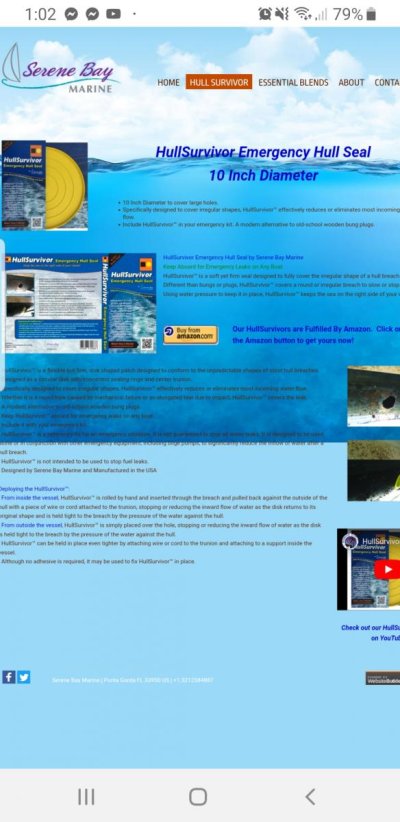offshore collision kit
in addition to my Milwaukee cordless drill and saws-all, with fresh and backup lithium batteries, life raft, ditch kit and EPIRB
... hitting a submerged container before you see it is a distinct, though low probability event... much better to be in your boat with all your supplies than in a rubber raft waiting for the coast-guard
collision control bag Contents:
1 large Waterproof duffel 1x
tru plug 1x
Collision mat with lines 2x
1 Silicone Sealing Tape, yellow 1x
1 Heavy Duty Cloth Duct Tape, 10 yds, 2 inches 1x
1 Gorilla Tape, 10 yds, 1 inches 1x
1 roll polyken white tape 1x
Folding Saw 1x
1 Cable Ties, 14" Long (qty 25) 1x
1 Yachtsman Knife with Marline Spike and Shackle Key 1x
1 POW-R Patch, 4 X 6" 2x
1 POW-R Wrap, 2" X 48" (3/4" Pipe) 1x
STIC-O-STEEL, 2 Oz Tube 2x
Devcon steep epoxy putty 1x
fiberglass repair kit- water activated 3" x 9 feet 1x
1 Oakum, Brown Oiled, 1 # Bag 1x
1 Tarred Marlin, 4 oz. 1x
ace bandages, 3" roll 2x
1 Softwood Plugs, Various sizes (qty 4) 1x
Softwood Plugs, 1.5" x 2 1x
Softwood Plugs, 3/4" x 3 1x
Softwood Plugs, 1.5" x 3 1x
Neoprene Sheet, 12x12 2x
Neoprene Sheet, 8x6. 2x
hack saw blades, 2 coarse, 2 fine 32T and 18T
1/4 plywood drilled with holes 4x
PK screws, #10 1.25 lg, bag of 100 1x
PK screws, #10 1.00 LG., bag of 100 1x
plywood with gasket - crash boards for all hatches and port-lights 2x
plywood battons for crash boards 8x
rubber bike tube 1x
clamps 3x small 1x long carpenter clamp 1x
west system epoxy and caulk gun 1x
Fast cure caulk 1x
Ryobi saw with blades- short blades 10x 1x
2 Wedges, 2 X 4" X 8" 1x
hack saw frame- ships supply ? Or store in collision bag 1x
1 Hand Ax 1x
1Pelican waterptoof Flashlight with spare batteries (AA) 1x
2 SAE 20 Stainless Steel Hose Clamp ( 1.25 - 1.75 ) 1x
2 SAE 36 Stainless Steel Hose Clamp (1.75 - 2.75) 1x
2 SAE 52 Stainless Steel Hose Clamp (2.75 - 3.75) 1x
2 SAE 80 Stainless Steel Hose Clamp (4 - 5.5) 1x
2 SAE 104 Stainless Steel Hose Clamp ( 5.5 - 7 ) 1x
1 Flexible Hose Clamp Driver 1x
1 Plywood Block (1/2" X 8" X 10")" 1x
1 Copper Sheet, .021" X 5" X 7" 1x
1 Split Fire Hose, 1 1/2" X 12" 1x


 )
)